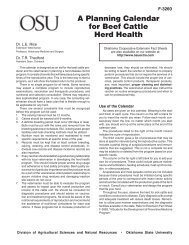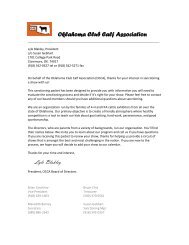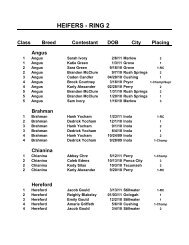Basics About Beef - the Oklahoma Club Calf Association
Basics About Beef - the Oklahoma Club Calf Association
Basics About Beef - the Oklahoma Club Calf Association
Create successful ePaper yourself
Turn your PDF publications into a flip-book with our unique Google optimized e-Paper software.
BUYING BEEF<br />
6<br />
There are several factors to consider as you<br />
purchase beef:<br />
wholesomeness<br />
quality<br />
appearance<br />
storage<br />
cost per serving and number to serve<br />
cookery method and time needed for preparation<br />
WHOLESOMENESS<br />
The first factor to consider when buying beef is<br />
wholesomeness, which has to do with <strong>the</strong> safety of<br />
food. Federal law requires that all meat sold must<br />
pass inspection for wholesomeness.<br />
MEAT INSPECTION<br />
The purpose of inspection is to assure <strong>the</strong> consumer<br />
that all meat sold is from healthy animals which<br />
were processed under sanitary conditions, and that<br />
<strong>the</strong> meat is safe to eat.<br />
Some states have <strong>the</strong>ir own inspection programs<br />
which regulate meat that is processed and sold<br />
only within that state. If a state does not have an<br />
inspection program or if <strong>the</strong> meat is to cross state<br />
or national lines, it must be federally inspected.<br />
Federal inspection is supervised by <strong>the</strong> USDA.<br />
Experienced veterinarians or specially trained,<br />
supervised inspectors inspect beef both before and<br />
after processing. <strong>Beef</strong> which passes federal inspection<br />
is stamped with a round, purple mark made with a<br />
safe-to-eat vegetable dye. The number inside <strong>the</strong><br />
mark is <strong>the</strong> official number assigned to <strong>the</strong> plant<br />
where <strong>the</strong> beef animal was processed.<br />
State inspected beef will usually have a different<br />
inspection mark which varies state to state. The<br />
inspection mark is generally placed only once on<br />
larger (wholesale) cuts, so it is unlikely you will see<br />
it on <strong>the</strong> cuts you buy.<br />
Whe<strong>the</strong>r done by <strong>the</strong> federal government or <strong>the</strong><br />
state government, beef inspection is extensive<br />
and thorough, resulting in U.S. meat<br />
products with a safety record envied<br />
throughout <strong>the</strong> world. In addition to<br />
inspection of animals and of processed<br />
meat at <strong>the</strong> plant, beef is subject to<br />
fur<strong>the</strong>r inspection as processing continues,<br />
in supermarket and meat market cutting<br />
rooms and in restaurant kitchens. For information<br />
on food safety in <strong>the</strong> home see page 14.<br />
38<br />
U.S.<br />
I N S P<br />
' D<br />
' D<br />
&<br />
' S<br />
P<br />
QUALITY<br />
Quality is a second factor to consider in buying beef.<br />
Quality refers to characteristics associated with <strong>the</strong><br />
palatability of <strong>the</strong> meat (tenderness, juiciness and<br />
flavor). The names you see on beef often indicate <strong>the</strong><br />
quality of <strong>the</strong> meat. These names may be ei<strong>the</strong>r <strong>the</strong><br />
USDA grade names or <strong>the</strong> meat packer and retailer<br />
brand names.<br />
USDA BEEF GRADING<br />
USDA meat grading is a voluntary service. Firms pay<br />
a fee to <strong>the</strong> USDA for <strong>the</strong> services provided by its<br />
graders, who are highly trained specialists employed<br />
by <strong>the</strong> agency.<br />
A grade mark is a shield-shaped symbol with <strong>the</strong><br />
letters USDA and <strong>the</strong> grade name (such as Choice).<br />
When a beef or veal carcass is graded, <strong>the</strong> grade mark<br />
is applied to <strong>the</strong> carcass with a safe-to-eat purple dye<br />
in a long, ribbon-like imprint. Prepackaged meats<br />
sometimes have grade shield stickers on <strong>the</strong> package.<br />
The top three of <strong>the</strong> eight beef grades are U.S. Prime,<br />
U.S. Choice and U.S. Select. These grades may be<br />
found in retail stores and meat markets.<br />
GRADES OF BEEF<br />
Prime: The grade of beef<br />
which contains <strong>the</strong> greatest<br />
degree of marbling.* It is<br />
generally sold to finer<br />
restaurants and to some<br />
selected meat stores. It is usually<br />
higher priced because it is produced<br />
in very limited quantities.<br />
Choice: The grade preferred<br />
by many consumers because it<br />
contains sufficient marbling<br />
for taste and juiciness. It is<br />
usually less costly than<br />
U.S. Prime.<br />
Select: Generally lower-priced<br />
grade of beef with less marbling<br />
than U.S. Choice. Select beef<br />
cuts are leaner but also less<br />
juicy and flavorful.<br />
*Marbling is <strong>the</strong> term for <strong>the</strong> small flecks of fat that are interspersed with <strong>the</strong><br />
lean (muscle). It contributes to juiciness and flavor.







